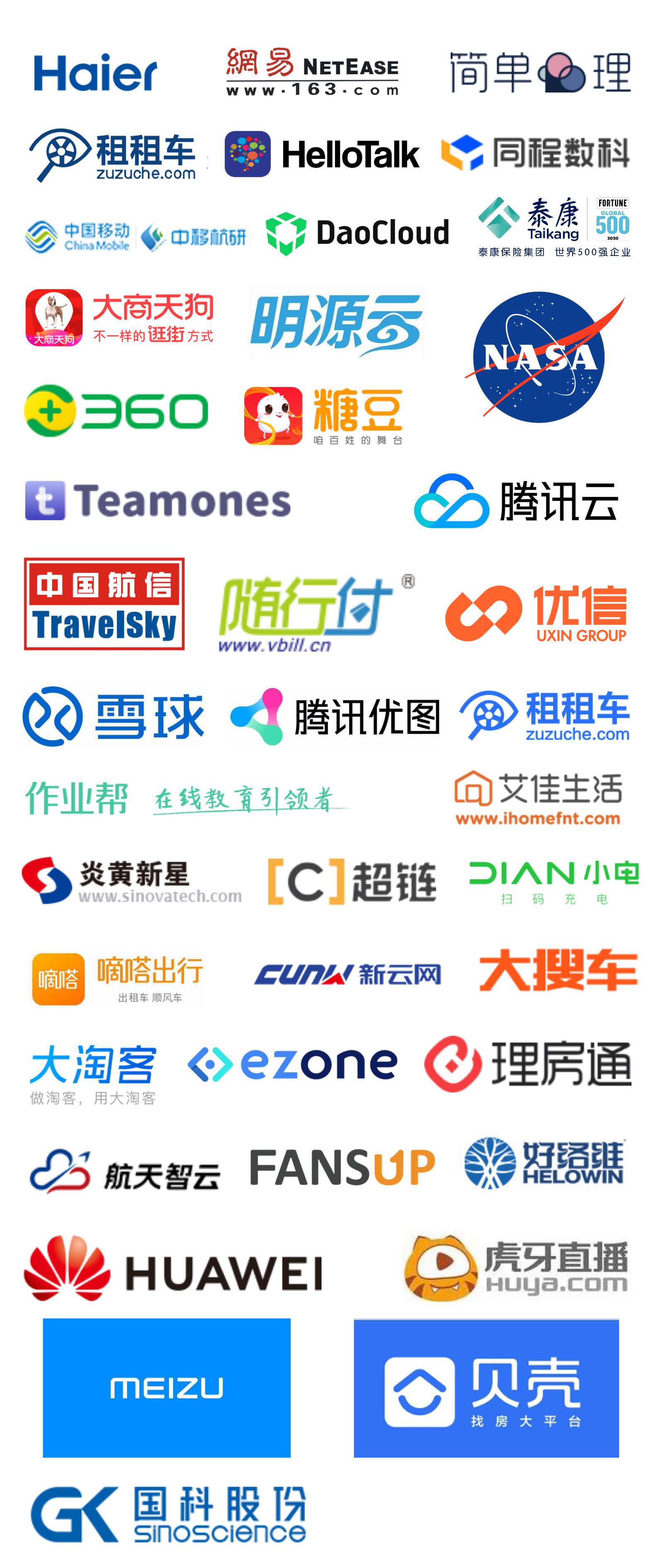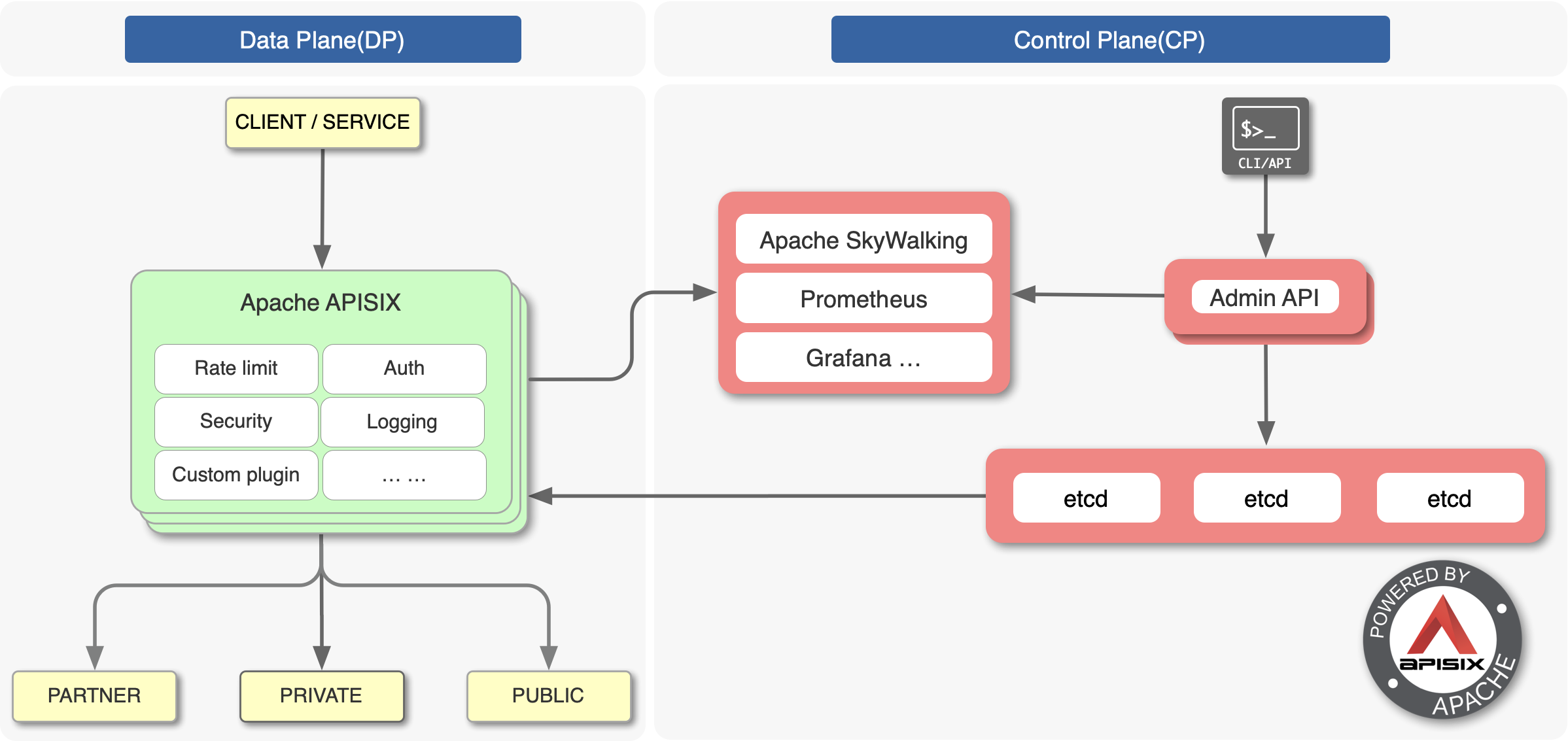|
|
||
|---|---|---|
| .github | ||
| apisix | ||
| benchmark | ||
| bin | ||
| ci | ||
| conf | ||
| docs | ||
| example/apisix | ||
| kubernetes | ||
| logos | ||
| rockspec | ||
| t | ||
| utils | ||
| .asf.yaml | ||
| .gitattributes | ||
| .gitignore | ||
| .gitmodules | ||
| .luacheckrc | ||
| .markdownlint.yml | ||
| CHANGELOG.md | ||
| CODE_OF_CONDUCT.md | ||
| CODE_STYLE.md | ||
| CONTRIBUTING.md | ||
| LICENSE | ||
| Makefile | ||
| NOTICE | ||
| powered-by.md | ||
| README.md | ||
Apache APISIX
Apache APISIX is a dynamic, real-time, high-performance API gateway.
APISIX provides rich traffic management features such as load balancing, dynamic upstream, canary release, circuit breaking, authentication, observability, and more.
You can use Apache APISIX to handle traditional north-south traffic, as well as east-west traffic between services. It can also be used as a k8s ingress controller.
The technical architecture of Apache APISIX:
Community
- Mailing List: Mail to dev-subscribe@apisix.apache.org, follow the reply to subscribe to the mailing list.
- QQ Group - 578997126
- Slack Workspace - join
#apisixon our Slack to meet the team and ask questions - follow and interact with us using hashtag
#ApacheAPISIX- bilibili video
- Good first issues:
Features
You can use Apache APISIX as a traffic entrance to process all business data, including dynamic routing, dynamic upstream, dynamic certificates, A/B testing, canary release, blue-green deployment, limit rate, defense against malicious attacks, metrics, monitoring alarms, service observability, service governance, etc.
-
All platforms
- Cloud-Native: Platform agnostic, No vendor lock-in, APISIX can run from bare-metal to Kubernetes.
- Run Environment: Both OpenResty and Tengine are supported.
- Supports ARM64: Don't worry about the lock-in of the infra technology.
-
Multi protocols
- TCP/UDP Proxy: Dynamic TCP/UDP proxy.
- Dubbo Proxy: Dynamic HTTP to Dubbo proxy.
- Dynamic MQTT Proxy: Supports to load balance MQTT by
client_id, both support MQTT 3.1.*, 5.0. - gRPC proxy: Proxying gRPC traffic.
- gRPC transcoding: Supports protocol transcoding so that clients can access your gRPC API by using HTTP/JSON.
- Proxy Websocket
- Proxy Protocol
- Proxy Dubbo: Dubbo Proxy based on Tengine.
- HTTP(S) Forward Proxy
- SSL: Dynamically load an SSL certificate.
-
Full Dynamic
- Hot Updates And Hot Plugins: Continuously updates its configurations and plugins without restarts!
- Proxy Rewrite: Support rewrite the
host,uri,schema,enable_websocket,headersof the request before send to upstream. - Response Rewrite: Set customized response status code, body and header to the client.
- Serverless: Invoke functions in each phase in APISIX.
- Dynamic Load Balancing: Round-robin load balancing with weight.
- Hash-based Load Balancing: Load balance with consistent hashing sessions.
- Health Checks: Enable health check on the upstream node and will automatically filter unhealthy nodes during load balancing to ensure system stability.
- Circuit-Breaker: Intelligent tracking of unhealthy upstream services.
- Proxy Mirror: Provides the ability to mirror client requests.
- Traffic Split: Allows users to incrementally direct percentages of traffic between various upstreams.
-
Fine-grained routing
- Supports full path matching and prefix matching
- Support all Nginx built-in variables as conditions for routing, so you can use
cookie,args, etc. as routing conditions to implement canary release, A/B testing, etc. - Support various operators as judgment conditions for routing, for example
{"arg_age", ">", 24} - Support custom route matching function
- IPv6: Use IPv6 to match the route.
- Support TTL
- Support priority
- Support Batch Http Requests
- Support filtering route by GraphQL attributes
-
Security
- Authentications: key-auth, JWT, basic-auth, wolf-rbac
- IP Whitelist/Blacklist
- Referer Whitelist/Blacklist
- IdP: Support external authentication services, such as Auth0, okta, etc., users can use this to connect to OAuth 2.0 and other authentication methods.
- Limit-req
- Limit-count
- Limit-concurrency
- Anti-ReDoS(Regular expression Denial of Service): Built-in policies to Anti ReDoS without configuration.
- CORS Enable CORS(Cross-origin resource sharing) for your API.
- URI Blocker: Block client request by URI.
- Request Validator
-
OPS friendly
- Zipkin tracing: Zipkin
- Open source APM: support Apache SkyWalking
- works with external service discovery:In addition to the built-in etcd, it also supports Consul and Nacos, and Eureka
- Monitoring And Metrics: Prometheus
- Clustering: APISIX nodes are stateless, creates clustering of the configuration center, please refer to etcd Clustering Guide.
- High availability: Support to configure multiple etcd addresses in the same cluster.
- Dashboard
- Version Control: Supports rollbacks of operations.
- CLI: start\stop\reload APISIX through the command line.
- Stand-Alone: Supports to load route rules from local YAML file, it is more friendly such as under the kubernetes(k8s).
- Global Rule: Allows to run any plugin for all request, eg: limit rate, IP filter etc.
- High performance: The single-core QPS reaches 18k with an average delay of fewer than 0.2 milliseconds.
- Fault Injection
- REST Admin API: Using the REST Admin API to control Apache APISIX, which only allows 127.0.0.1 access by default, you can modify the
allow_adminfield inconf/config.yamlto specify a list of IPs that are allowed to call the Admin API. Also, note that the Admin API uses key auth to verify the identity of the caller. Theadmin_keyfield inconf/config.yamlneeds to be modified before deployment to ensure security. - External Loggers: Export access logs to external log management tools. (HTTP Logger, TCP Logger, Kafka Logger, UDP Logger)
- Helm charts
-
Highly scalable
- Custom plugins: Allows hooking of common phases, such as
rewrite,access,header filter,body filterandlog, also allows to hook thebalancerstage. - Plugin can be writtern in Java/Go
- Custom load balancing algorithms: You can use custom load balancing algorithms during the
balancerphase. - Custom routing: Support users to implement routing algorithms themselves.
- Custom plugins: Allows hooking of common phases, such as
Get Started
- Installation
APISIX Installed and tested in the following systems:
CentOS 7, Ubuntu 16.04, Ubuntu 18.04, Debian 9, Debian 10, macOS, ARM64 Ubuntu 18.04
Please refer to install documentation.
-
Getting started
The getting started guide is a great way to learn the basics of APISIX. Just follow the steps in Getting Started.
Further, you can follow the documentation to try more plugins.
-
Admin API
Apache APISIX provides REST Admin API to dynamically control the Apache APISIX cluster.
-
Plugin development
You can refer to plugin development guide, and sample plugin
example-plugin's code implementation. Reading plugin concept would help you learn more about the plugin.
For more documents, please refer to Apache APISIX Documentation site
Benchmark
Using AWS's eight-core server, APISIX's QPS reaches 140,000 with a latency of only 0.2 ms.
Benchmark script, test method and process has been open source, welcome to try and contribute.
Apache APISIX vs. Kong
Both of them have been covered core features of API gateway
| Features | Apache APISIX | KONG |
|---|---|---|
| Dynamic upstream | Yes | Yes |
| Dynamic router | Yes | Yes |
| Health check | Yes | Yes |
| Dynamic SSL | Yes | Yes |
| L4 and L7 proxy | Yes | Yes |
| Opentracing | Yes | Yes |
| Custom plugin | Yes | Yes |
| REST API | Yes | Yes |
| CLI | Yes | Yes |
The advantages of Apache APISIX
| Features | Apache APISIX | Kong |
|---|---|---|
| Belongs to | Apache Software Foundation | Kong Inc. |
| Tech Architecture | Nginx + etcd | Nginx + Postgres |
| Communication channels | Mail list, Wechat group, QQ group, GitHub, Slack, meetup | GitHub, Freenode, forum |
| Single-core CPU, QPS(enable limit-count and Prometheus plugins) | 18000 | 1700 |
| Latency | 0.2 ms | 2 ms |
| Dubbo | Yes | No |
| Configuration rollback | Yes | No |
| Route with TTL | Yes | No |
| Plug-in hot loading | Yes | No |
| Custom LB and route | Yes | No |
| REST API <--> gRPC transcoding | Yes | No |
| Tengine | Yes | No |
| MQTT | Yes | No |
| Configuration effective time | Event-driven, < 1ms | polling, 5 seconds |
| Dashboard | Yes | No |
| IdP | Yes | No |
| Configuration Center HA | Yes | No |
| Speed limit for a specified time window | Yes | No |
| Support any Nginx variable as routing condition | Yes | No |
Benchmark comparison test details data
Contributor Over Time
visit here to generate Contributor Over Time.
Videos And Articles
- Apache APISIX: How to implement plugin orchestration in API Gateway
- Improve Apache APISIX observability with Apache Skywalking
- APISIX technology selection, testing and continuous integration
- Analysis of Excellent Performance of Apache APISIX Microservices Gateway
User Stories
- European Factory Platform: API Security Gateway – Using APISIX in the eFactory Platform
- ke.com: How to Build a Gateway Based on Apache APISIX(Chinese)
- 360: Apache APISIX Practice in OPS Platform(Chinese)
- HelloTalk: Exploring Globalization Based on OpenResty and Apache APISIX(Chinese)
- Tencent Cloud: Why choose Apache APISIX to implement the k8s ingress controller? (Chinese)
- aispeech: Why we create a new k8s ingress controller? (Chinese)
Who Uses APISIX?
A wide variety of companies and organizations use APISIX for research, production and commercial product, including:

Users are encouraged to add themselves to the Powered By page.
Landscape


APISIX enriches the
CNCF API Gateway Landscape.
Logos
Acknowledgments
Inspired by Kong and Orange.

